I've been away on a short vacation and it seems my grafted Lophophora williamsii (SB 854; Starr Co, Tx) has spent its "lone time" wisely and grown three flowers.
Lophophora williamsii displaying three flowers
Even though the flowers were already quite open when I returned home, I decided to attempt a time-lapse video showing the flowers open fully. Unfortunately I forgot to disable the cameras autofocus function which gives the video a shaky appearance as the camera continuously changes focus slightly.
That being said, I'm impressed by the agility of the Lophophora stamens - they seem almost to be dancing around the style. A dazzling display of thigmotropic behavior is shown 50some seconds into the video; the stamens are disturbed and fold rapidly in around the style only to resume their perpetual wiggle shortly after. In contrast to this Epithelantha micromeris v. greggii stamens never seem to move during flowering.
I yet haven't managed to create a time-lapse video that is fully satisfying (the flower must be shown from bud to full bloom, the image must not shake/autofocus, no drop outs must occur in the stream of images, etc). I'll keep trying though, but I'll bet that when everything is set for the perfect time-lapse the shutter of my good old D70 gives up the ghost just before the shoot is finished ;-)
The photos for the time-lapse were shot at intervals of 15 seconds during a period of 160 minutes. The pictures are played back at a rate of 10 frames per second, i.e. the flowering is speed up by a factor of 150 resulting in a video running for 64 seconds.
Sunday, May 04, 2008
Time-lapse video of a flowering Lophophora williamsii
Friday, August 17, 2007
Time-lapse videos of a flowering Lophophora jourdaniana
I’ve previously made an attempt at a stop-motion video showing the thigmotropic behavior of Lophophora stamens. It so happened that the Lophophora williamsii var. jourdaniana plant flowered again during my summer vacation, leaving me plenty of time to experiment with time-lapse videos.
The first video shows the Lophophora williamsii var. jourdaniana flower unfold (I’m not exactly an early bird so I missed the first part of the unfolding ;-)
The above video covers a time span of approximately 90 minutes, i.e. playback is sped up by a factor of 150. This is my first attempt at a time-lapse “flower movie”, as can be seen by the quality of the film. The first 11 seconds were shot while the camera was in auto-focus mode, resulting in a “wobbly” feel. I then disabled auto-focus (and lost a couple of frames in the process, which can be seen as a “jump” 11 seconds into the video) and later had to re-focus (28 seconds into the video), so it's not perfect, but not bad either. The frames were shot with the sun as the only source of light.
Next, I wanted to make a better (i.e. more frames per second) version of the thigmotropic stamens video but ended up with a version looking a lot like the original one.
The playback of the above video is sped up by a factor of 12. Unfortunately I stopped taking pictures just as the stamens started to revert to their original position. In an attempt to achieve more frames per second I played around with my cameras continuous shooting mode. Suddenly the flower was visited by an industrious bee beautifully illustrating the purpose of the touch sensitive stamens ;-)
I guess the last 2 clips would be more illustrative if they had been filmed with a regular video camera instead of an SLR, but they’ll have to do for now. Unfortunately my camera ran out of power effectively putting an end to the filming of this particular flower.
Finally I have to mention the Hydrocactus – cactus video page as the main inspiration for these experiments and the best source of cactus videos I’m aware of.
Monday, June 11, 2007
Flowering Lophophora jourdaniana, take two.
One of my Lophophora williamsii v. jourdaniana plants is flowering again – this time with the full cooperation of the sun, resulting in a much more well-developed flower compared to the previous one.
Flowering Lophophora jourdaniana
My two Lophophora williamsii v. jourdaniana plants are almost in full compliance with Habermann’s description (rose-violet perianth, pistil, and filaments; persistent spines on young areoles) but the open flower clearly contradicts Habermann’s claim of cleistogamic flowers (i.e. flowers that do not open and are self pollinated). Apparently Habermann misunderstood or used this term incorrectly as the photo accompanying the type description also shows a plant with an open flower ;-)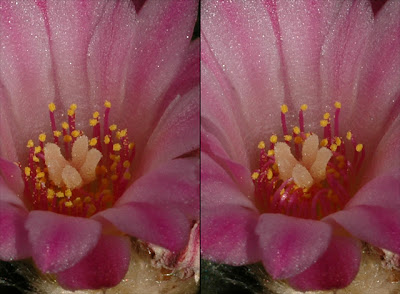
Lophophora jourdaniana – thigmotropic stamens
Like many other species of cacti (including the other Lophophora species/varieties) L. jourdaniana has thigmotropic stamens, i.e. stamens that when touched fold in around the style (as is evident for the front stamens in the rightmost picture).
The following stop motion video provides a better illustration of the thigmotropic mechanism - I'll try to make a higher quality movie the next time the plant flowers.
References
Vlastimil Habermann (1975), “Lophophora jourdaniana Habermann species nova”, Kaktusy 11 (1), 3
Thursday, August 24, 2006
Flowering Lophophora williamsii – III
My Lophophora williamsii (SB 854; Starr Co, Tx) graft has gone on a flowering spree and is currently flashing its 7th and 8th flower this season.
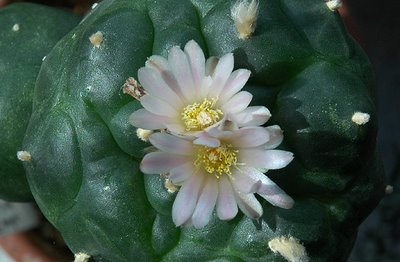
Flowering Lophophora williamsii
Like other species of Lophophora, L. williamsii has sensitive stamens, closing around the style when touched.
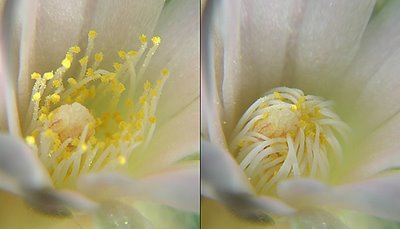
L. williamsii stamens closing around the style
In this flower the anthers are actually brushing the stigmas when the stamens react to a touch, i.e. the thigmotropic reaction will assist the flower to self-pollinate. I have to test if this is sufficient to pollinate the flower (in a previous post I also wondered if it was necessary to manually self-pollinate the Lophophora williamsii (SB 854; Starr Co, Tx) flowers or if they could cope without any help ;-)
For comparison you can check a photo of thigmotropic behavior in Lophopohora jourdaniana. In this case the stamens fold in below the stigmas, apparently not touching them.
The fruits (or berries, pods, whatever;-) from the plants first two flowers this season have just appeared.
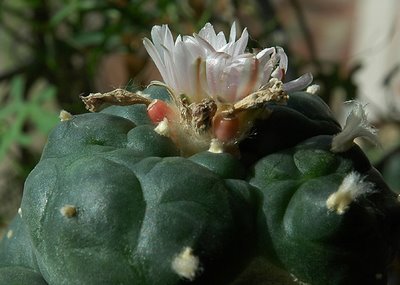
Lophophora williamsii fruits
I’m looking forward to see how many of the flowers will actually result in a fruit.
< previous |
Monday, July 31, 2006
Flowering Lophophora williamsii v. jourdaniana
According to Habermann’s description Lophophora williamsii v. jourdaniana differs from other L. williamsii varieties by having rose-violet perianth, pistil and filaments as well as having small persistent spines on young areoles. 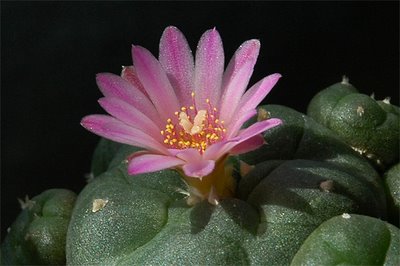
Flowering Lophophora williamsii v. jourdaniana
One of my Lophophora williamsii v. jourdaniana plants flowered today, beautifully illustrating the description (even some spines can be seen faintly in the photos ;-)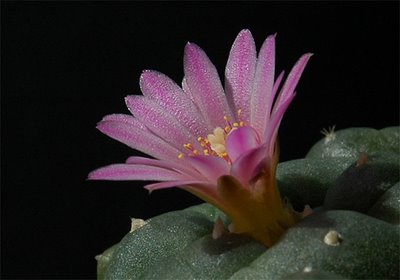
Lophophora williamsii v. jourdaniana flower
Like L. williamsii v. williamsii the jourdaniana variety has thigmotropic stamens, i.e. stamens that when touched fold in around pollinating insects or the style. I wonder if this mechanism is used for actively depositing pollen on pollinators or for avoiding self-pollination (or both)?
L. williamsii v. jourdaniana – thigmotropic stamens
The flowering of this plant coincided with the flowering of my grafted Lophophora williamsii (SB 854; Starr Co, Tx). I decided not to outcross the plants but instead self-pollinate both of them; first of all to keep my SB 854’s “clean”, but also because I want to test the alleged self-incompatibility of the jourdaniana variety.
This Lophophora williamsii v. jourdaniana plant also flowered last year – it was then outcrossed with pollen from a regular L. williamsii and yielded 2 seeds.
All Time Most Popular Posts
-
Lophophora williamsii (peyote) populations have diminished in large areas of South Texas where peyoteros harvest the cactus for ceremonial ...
-
On various occasions I've been asked what growing media I'm using for my cactus plants. I don't have a set soil mix recipe as su...
-
Below is a list of retailers/nurseries selling cactus seed and plants. I've only listed vendors I've done business with. If you ar...
-
Most cacti are easily grown from seed - and with a little patience and care they can be grown into beautiful plants. Lophophora williamsi...
-
In last month’s post on the troubled Texan peyoteros I referred to Anderson’s article on the peyote situation in Texas. Given the importanc...
-
Yet another slightly off topic and probably not entirely politically correct post, but I couldn’t help noticing the similarity of my monstr...
-
Flowering stand of San Pedro cacti (Trichocereus pachanoi) To me the main draw of the San Pedro cactus ( Trichocereus pachanoi (syn. Ech...
-
In the June 2008 issue of the Cactus & Co magazine Jaroslav Šnicer, Jaroslav Bohata, and Vojtěch Myšák described a new Lophophora spec...
-
There seems to be an increased focus on the alarming Texas peyote situation. A couple of weeks ago the Houston Press published a mournful, i...
-
I spent two weeks working in Delhi, India during January. I had one weekend off and had planned to spend it in Delhi at my own leisure, but ...


















